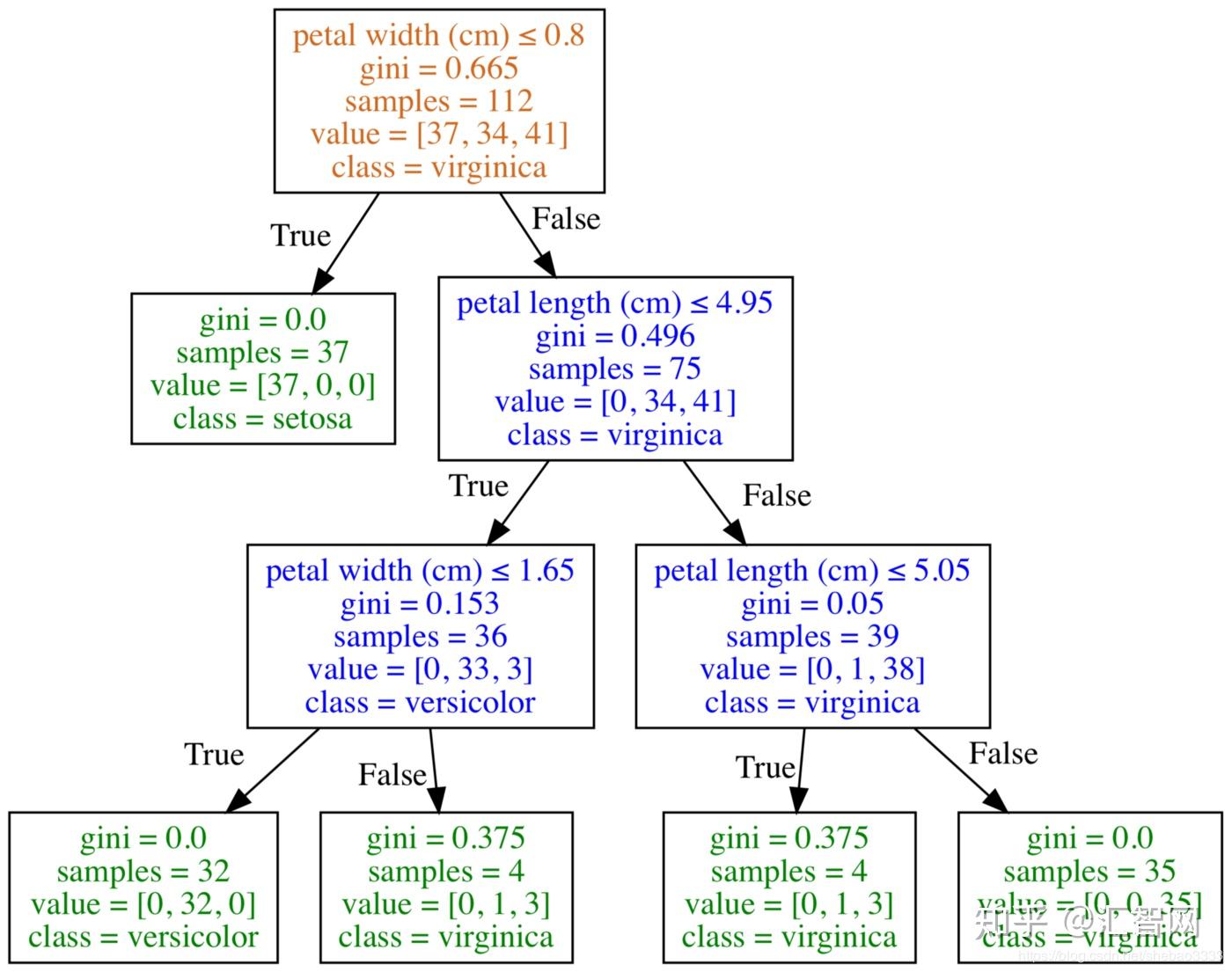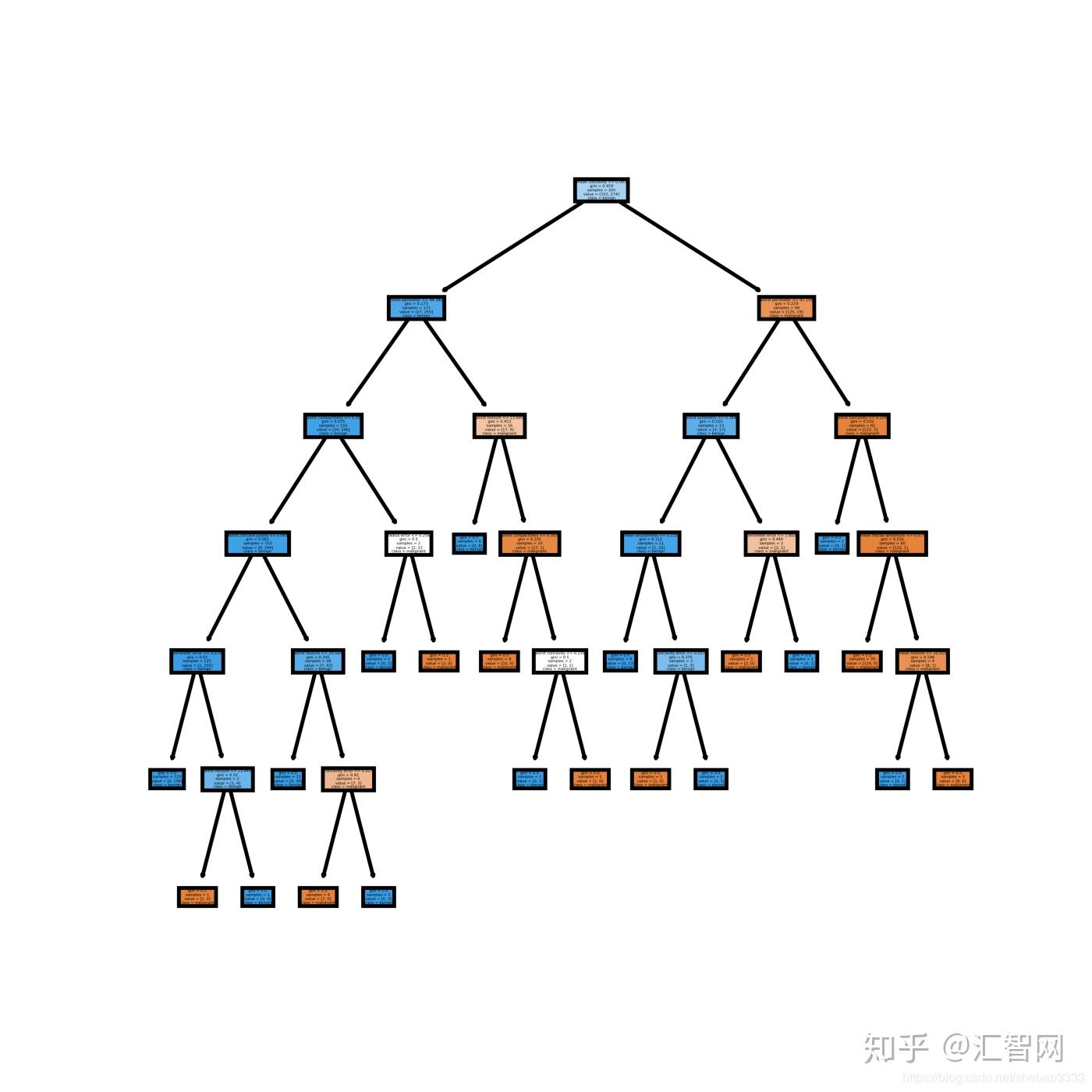决策树可视化
决策树是一种流行的有监督学习方法。决策树的优势在于其既可以用于回归,也可以用于分类,不需要特征缩放,而且具有比较好的可解释性,容易将决策树可视化。可视化的决策树不仅是理解你的模型的好办法,也是向其他人介绍你的模型的运作机制的有利工具。因此掌握决策树可视化的方法对于数据分析工作者来说非常重要。
机器学习相关教程: TensorFlow实战 | 机器学习基础 | 深入浅出Flask | Python基础
在这个教程里,我们将学习以下内容:
- 如何使用scikit-learn训练一个决策树模型
- 如何使用Matplotlib将决策树可视化
- 如何使用Graphviz将决策树可视化
- 如何将随机森林或决策树包中的单个决策树可视化
教程的代码可以从 这里 下载。现在让我们开始吧。
1、用scikit-learn训练决策树模型
为了可视化决策树,我们首先需要用scikit-learn训练出一个决策树模型。
首先导入必要的Python库:
import matplotlib.pyplot as plt
from sklearn.datasets import load_iris
from sklearn.datasets import load_breast_cancer
from sklearn.tree import DecisionTreeClassifier
from sklearn.ensemble import RandomForestClassifier
from sklearn.model_selection import train_test_split
import pandas as pd
import numpy as np
from sklearn import tree然后载入iris数据集。scikit-learn内置了Iris数据集,因此我们不需要从其他网站下载了。下面的Python代码载入Iris数据集:
import pandas as pd
from sklearn.datasets import load_irisdata = load_iris()
df = pd.DataFrame(data.data, columns=data.feature_names)
df['target'] = data.targetIris数据集看起来是这样:

接下来我们将Iris数据集拆分为训练集和测试集:
X_train, X_test, Y_train, Y_test = train_test_split(df[data.feature_names], df['target'], random_state=0)分割后的Iris数据集看起来是这样:

最后,我们采用scikit-learn经典的4步模式训练决策树模型:
# Step 1: Import the model you want to use
# This was already imported earlier in the notebook so commenting out
#from sklearn.tree import DecisionTreeClassifier
# Step 2: Make an instance of the Model
clf = DecisionTreeClassifier(max_depth = 2,
random_state = 0)
# Step 3: Train the model on the data
clf.fit(X_train, Y_train)
# Step 4: Predict labels of unseen (test) data
# Not doing this step in the tutorial
# clf.predict(X_test)2、使用Matplotlib将决策树可视化
从scikit-learn 版本21.0开始,可以使用scikit-learn的
tree.plot_tree
方法来利用matplotlib将决策树可视化,而不再需要依赖于难以安装的dot库。下面的Python代码展示了如何使用scikit-learn将决策树可视化:
tree.plot_tree(clf);
决策树可视化结果如下:

还可以添加一些额外的Python代码以便让绘制出的决策树具有更好的
可解读性,例如添加特征和分类名称:
fn=['sepal length (cm)','sepal width (cm)','petal length (cm)','petal width (cm)']
cn=['setosa', 'versicolor', 'virginica']
fig, axes = plt.subplots(nrows = 1,ncols = 1,figsize = (4,4), dpi=300)
tree.plot_tree(clf,
feature_names = fn,
class_names=cn,
filled = True);
fig.savefig('imagename.png')增加了更多信息的决策树可视化结果如下:

3、使用Graphviz将决策树可视化
下图是使用Graphviz得到的决策树可视化结果:

Graphviz是一个开源的图(Graph)可视化软件,采用抽象的图和网络来表示结构化的信息。在数据科学领域,Graphviz的一个用途就是实现决策树可视化。我将graphviz方法放在matplotlib方法之后,是因为这个软件用起来有点复杂。
为了将决策树可视化,首先需要创建一个dot文件来描述决策树,这个倒不难。问题在于使用Graphviz将dot文件转换为图形文件,例如png、jpg等等可能会有点难度。
有一些办法来降低graphviz的使用门槛,例如通过Anaconda安装python-graphviz、利用mac的homebrew安装grahpviz、利用官方提供的windows安装文件、或者使用在线转换器将决策树的dot文件转换为图形:

首先我们将决策树模型导出为dot文件:
tree.export_graphviz(clf,
out_file="tree.dot",
feature_names = fn,
class_names=cn,
filled = True)然后我们用conda安装graphviz:
conda install python-graphviz现在就可以将决策树模型导出的dot文件转换为图形文件了:
dot -Tpng tree.dot -o tree.png4、将决策树包或随机森林里的单个决策树可视化
决策树的一个缺点是通常其预测精度不够好。这部分原因在于其变化幅度比较大,对训练数据的不同拆分方式可能会生成截然不同的决策树模型。

上图可以表示决策树包或者随机森林模型之类的组合学习方法,通过将多个机器学习算法组合起来以期获得更好的预测性能。在这一部分,我们学习如何将这些组合模型中的单个决策树可视化。
首先还是使用scikit-learn来训练得到一个随机森林模型:
# Load the Breast Cancer (Diagnostic) Dataset
data = load_breast_cancer()
df = pd.DataFrame(data.data, columns=data.feature_names)
df['target'] = data.target
# Arrange Data into Features Matrix and Target Vector
X = df.loc[:, df.columns != 'target']
y = df.loc[:, 'target'].values
# Split the data into training and testing sets
X_train, X_test, Y_train, Y_test = train_test_split(X, y, random_state=0)
# Random Forests in `scikit-learn` (with N = 100)
rf = RandomForestClassifier(n_estimators=100,
random_state=0)
rf.fit(X_train, Y_train)现在我们可以将模型中的单个决策树可视化。首先还是使用matplotlib。下面的python代码将第1个决策树可视化:
fn=data.feature_names
cn=data.target_names
fig, axes = plt.subplots(nrows = 1,ncols = 1,figsize = (4,4), dpi=800)
tree.plot_tree(rf.estimators_[0],
feature_names = fn,
class_names=cn,
filled = True);
fig.savefig('rf_individualtree.png')得到的这个决策树可视化结果如下:

你可以试着使用matplotlib的subplot来将你期望的多个决策树可视化。例如下面的Python代码将组合模型中的前5个决策树可视化:
# This may not the best way to view each estimator as it is smallfn=data.feature_names
cn=data.target_names
fig, axes = plt.subplots(nrows = 1,ncols = 5,figsize = (10,2), dpi=3000)for index in range(0, 5):
tree.plot_tree(rf.estimators_[index],
